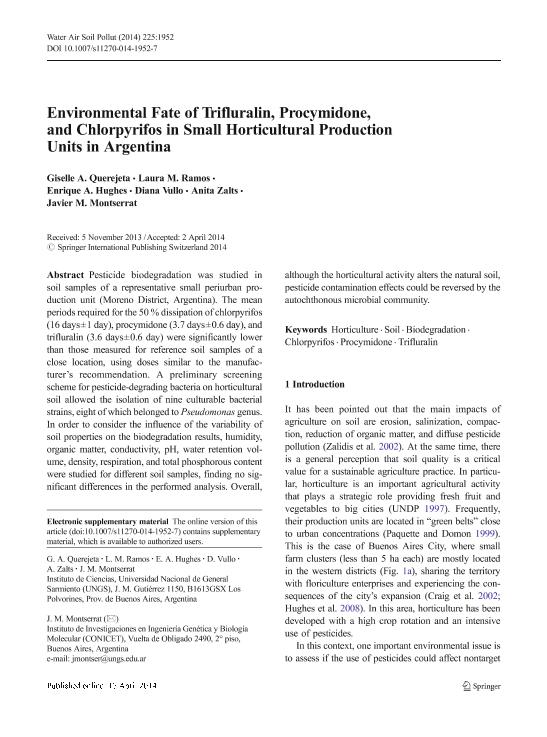Artículo
Environmental Fate of Trifluralin, Procymidone, and Chlorpyrifos in Small Horticultural Production Units in Argentina
Querejeta, Giselle Andrea ; Ramos, Laura Mabel
; Ramos, Laura Mabel ; Hughes, Enrique Alejandro; Vullo, Diana Lia
; Hughes, Enrique Alejandro; Vullo, Diana Lia ; Zalts, Anita; Montserrat, Javier Marcelo
; Zalts, Anita; Montserrat, Javier Marcelo
 ; Ramos, Laura Mabel
; Ramos, Laura Mabel ; Hughes, Enrique Alejandro; Vullo, Diana Lia
; Hughes, Enrique Alejandro; Vullo, Diana Lia ; Zalts, Anita; Montserrat, Javier Marcelo
; Zalts, Anita; Montserrat, Javier Marcelo
Fecha de publicación:
05/2014
Editorial:
Springer
Revista:
Water, Air and Soil Pollution
ISSN:
0049-6979
e-ISSN:
1573-2932
Idioma:
Inglés
Tipo de recurso:
Artículo publicado
Clasificación temática:
Resumen
Pesticide biodegradation was studied in soil samples of a representative small periurban production unit (Moreno District, Argentina). The mean periods required for the 50% dissipation of chlorpyrifos (16 days±1 day), procymidone (3.7 days±0.6 day), and trifluralin (3.6 days±0.6 day) were significantly lower than those measured for reference soil samples of a close location, using doses similar to the manufacturer?s recommendation. A preliminary screening scheme for pesticide-degrading bacteria on horticultural soil allowed the isolation of nine culturable bacterial strains, eight of which belonged to Pseudomonas genus. In order to consider the influence of the variability of soil properties on the biodegradation results, humidity, organic matter, conductivity, pH, water retention volume, density, respiration, and total phosphorous content were studied for different soil samples, finding no significant differences in the performed analysis. Overall, although the horticultural activity alters the natural soil, pesticide contamination effects could be reversed by the autochthonous microbial community.
Palabras clave:
Horticulture
,
Biodegradation
,
Chlorpyrifos
,
Procymidone
,
Trifluralin
,
Soil
Archivos asociados
Licencia
Identificadores
Colecciones
Articulos(INGEBI)
Articulos de INST.DE INVEST.EN ING.GENETICA Y BIOL.MOLECULAR "DR. HECTOR N TORRES"
Articulos de INST.DE INVEST.EN ING.GENETICA Y BIOL.MOLECULAR "DR. HECTOR N TORRES"
Articulos(SEDE CENTRAL)
Articulos de SEDE CENTRAL
Articulos de SEDE CENTRAL
Citación
Querejeta, Giselle Andrea; Ramos, Laura Mabel; Hughes, Enrique Alejandro; Vullo, Diana Lia; Zalts, Anita; et al.; Environmental Fate of Trifluralin, Procymidone, and Chlorpyrifos in Small Horticultural Production Units in Argentina; Springer; Water, Air and Soil Pollution; 225; 5-2014; 1-13
Compartir
Altmétricas



